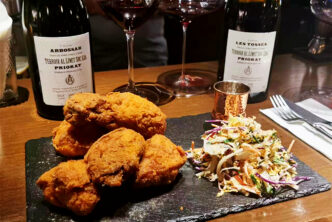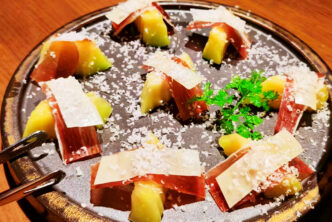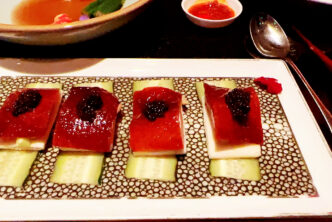Chez JOJO
3/F, A Mansion,
291 Fumin Lu
Xuhui District
Shanghai, China
The food
Charcuterie board
Escargot
Prawns with cocktail sauce
Fines de Claire oysters
Fried frog’s legs
Baked yellow croaker
The wines
Ferrari 2010 Trentodoc Riserva Perlé Nero 95
Bordelet Sydre Argelette 92
Schlumberger 2020 Riesling Saering Grand Cru 93

When it comes to French bistros and restaurants in Shanghai, the gold standard has long been established by Nicolas Le Bec, the former two Michelin starred chef from Lyon whose dining empire in Shanghai is one on which the sun never sets. Many in the city have since taken up the trial balloon, and the Magic City is now replete with numerous easier-going French eateries where good wine and food are served without you having to mortgage the house. Of all of them, an argument can be made that Chez JOJO is one of the very best at recreating the bistro experience of France.
Bistro, or perhaps more accurately, guinguette, that typical dining destination of the French countryside (the Loire, especially). The original Chez JOJO opened in 2018 at the corners of Fenyang and Yueyang roads, and closed in 2020. It has since been followed up by other Chez JOJOs at different addresses within the city. And while the fare is always more or less the same, each offers a different environment in which to dine: the Chez JOJO on Jongjia road features the option of garden dining, while the one on Fumin road (and the subject of this restaurant review) offers two gorgeous terraces for likewise fabulous al fresco dining.

First things first, lest I forget: while the address of the latter Chez JOJO says Fumin road, the restaurant’s entrance is really on Changle road, the street that intersects Fumin road. If you come by taxi, the driver will leave you at the intersection of Fumin and Changle, from where it’s just a brief hop, skip and jump to Chez JOJO, located on the third floor of a building on Changle road.
The great thing about this Chez JOJO is just how much fun the place is. Beautifully designed and appointed, the room is spacious and comfortable, all done out in leather and wood, with a small see-through wine cellar to the right of the entrance and a very long bar counter to the left. Just outside the main dining room are the two terraces, full of plants and just as spacious as the inside area. It all makes for an extremely comfortable feel and a relaxing meal. Part of that relaxed settings also stems from the food, as this is a haven of French comfort food: foie gras, escargot, terrines, oysters, frog legs, beef tartare, grilled lamb, boudin noir (French black sausage historically made with pig’s blood, though in this day and age the red coloration is arrived at most often by using beets) served with caramelized apples and mashed potatoes, confit lamb shoulder and charcuterie boards are everywhere. But if you like something simpler like steak, then you’re in luck too, because the place cooks up some huge slabs of beef, including tomahawks. Say what you will, but owner Maggie Shen and her restaurant director of the Fumin road branch Arnaud Cazes have done a masterful job.

Arnaud Cazes also has a long background in the restaurant world, spending most of his time in standalone restaurants. He trained in France where he acquired a Vocational Baccalaureate in Hospitality Management. He began his career in the world of dining in Paris, mainly working in bistros and brasseries, before going off to work in different countries such as Ireland, Australia, the U.A.E and, last but not least, China. When in Dubai, he worked for The Ritz-Carlton Hotel Company as well as the Fairmont Hotels & Resorts group managing the restaurants. He came to Shanghai to work for the Shangri-La Hotel (in the Jing’An district) where he managed two of the city’s more important eateries, 1515 West Steakhouse and its sister restaurant, Calypso.
Not just the food, but the wines are excellent too at Chez JOJO: even better, they are also very reasonably priced. Unlike other French restaurants in the city, the place eschews piling on the uber-famous and “bragging rights” sort of labels, preferring instead to offer excellent wines from many diverse regions and estates of France. So while you’ll find wines from outstanding producers like Domaine de L’Ecu and Schlumberger, the great thing about Chez JOJO is that there is a bounty of many very inexpensive wines from everywhere in the Hexagon (Touraine, Gigondas, Champagne, Jura…), and that includes some really outstanding ciders too. The merit for this goes to Arnaud, who is in charge of the wine list orientation and conception as well as the wine selection. While he modestly admits he does not have a specific education in oenology or wine tasting, he has developed such a passion for wine over the years that nowadays he is more informed about French wines than are some of the city’s certified somms.
Chez JOJO is such a reliable provider of French comfort food that I come here precisely for that: and so, my choices never change much, and I always have the same dishes. Escargot, raw shrimp, oysters, frog legs and the tartare (though depending on who I am with, the boudin noir is another frequent choice). Of all these dishes, the first thing that needs to be mentioned is the quality and freshness of the ingredients. For example, the raw shrimp are some of the city’s best and the oysters are close to that level too. Clearly, when it comes to oysters it depends on what your individual taste preference runs to: at Chez JOJO they serve the French Fin de claires, rather than oysters from New Zealand, Ireland and other parts of the world. It’s not that the French oysters are better than those from other places, but they do have a very recognizably different texture and flavour. That diversity in flavour is obvious even between French oysters: for example, France’s famous Belon oyster (named after the Belon river in Brittany) has a typically metallic nuance due to the river’s high water iron content, and is an acquired taste; by contrast, the just as famous Gillardeau farmed in the waters of southwestern France in the Marennes-Oléron region are also plump and meaty, but have a much sweeter, nuttier flavour. In comparison, the Fine de Claire oyster, also farmed in the Marennes-Oléron region (though generally in shallower water) is very recognizably briny and fresh, but because these oysters are placed in claires or oyster ponds (hence the variety’s name) for a period of time, they develop a milder taste and a creamier texture. In fact, Fine de Claire is but one type of this oyster: depending on their maturity level, they can be divided into Fine de Claire, Speciale de Claire and Pousse en Claire. The more mature the oyster, the meatier it is. If you like the zing of the Fine de Claire, then Chez JOJO is the place for you.

Of the various dishes on the menu, I strongly recommend the frog legs (not the easiest things to eat in the world, but so delicious) and the boudin noir. Boudin noir or blood sausage is one of France’s oldest sausage preparations, with a history that goes back something like 2000 years. It is mostly made with a mix of blood, fat, cooked onions, meat and other ingredients: in reality, recipes vary greatly, with every household and butcher shop, even a few blocks removed from each other, using a different, secret mix of ingredients. Very perishable, it should be consumed over the course of a couple of days at most but with beet juice having substituted pig’s blood in modern recipes this issue is less cogent than before. Blood sausage can be eaten in many different ways; usually, they are eaten fried or grilled, and accompanied by potatoes and/or apples. The apples can be served acidulated with lemon in a compote or as caramelized wedges (which they use at Chez JOJO); no matter which you might prefer, both are great accompaniments, for the apple preparation adds a lovely sweetness to the dish and nice acid lift, providing a welcome taste contrast with the saltier and fattier sausage.

I love the wine choices at Chez JOJO and had another great time matching my food with the wines I chose. The Ferrari 2010 Trentodoc Riserva Perlé Nero is, to put it in the simplest, most direct way possible, one of Italy’s greatest bubblies. From a very good vintage, this is a Blanc de Noirs (100% Pinot Noir as there is very little Pinot Meunier in Italy) that is remarkably light on its feet, high in harmonious acidity and very refreshing. In fact, save for the slightly bigger texture that the Pinot Noir delivers, this is actually so lifted and piercing that it will no doubt strike you as one of the most vibrant and airy Blanc de Noirs ever, in fact so light and airy that it shares more than a personality trait with a high-end Blanc de Blancs. White flowers, custard cream and orchard fruit are complemented by zingy citrus fruit and sweet spices on the long penetrating finish. Just a knockout bubbly wine made by the uber-talented Lunelli family out of Trento. It proved a great way to start off the meal but of course held its own more than a little well with many of the dishes, such as for example the frogs legs. The Eric Bordelet Sydre Argelette is one of France’s best, from a recognized master of the drink, one who makes many different types of apple cider (and is a very good Poiré from pears). The Argelette is a bit sharper and certainly more powerful than other ciders in the Bordelet stable, with a nutty and spicy nuance to the rich layered apple flavours. The apples (a blend of 40% bitter, 40% sweet and 20% lemony) are picked from hundred years old trees planted on schistous and sedimentary rocky soils dating back to three billion years (argelette is the name of schistous stones). Clearly, for those preferring bone-dry whites best to opt for something else, and so the serious, very age-worthy Schlumberger 2020 Riesling Saering Grand Cru fits the bill nicely. The Saering is a marl/limestone/sandstone site that pushes out in the plain like a circular tongue of land (saering means “ring”) that has been famous since 1250 at least. Classically dry, Schlumberger’s 2020 is a really beautiful wine, offering lovely delicate aromas and flavours of white flowers and orchard fruit with a noteworthy saline presence.
In ultimate analysis, at Chez JOJO they believe in providing an authentic bistro experience, with a price point and a generosity of portions that are not just commendable, but are key elements of this bistro’s dining experience. No doubt, Chez JOJO is casual and friendly: but as this write-up has probably helped you understand, it is also very upscale, in many respects. It’s really is one of my go-to spots in the city, and one of my favourite Shanghai restaurants for everyday dining.


 English
English



